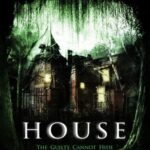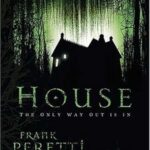At what point do horror movie clichés surpass campy entertainment? On the basis of “House,” an adaptation of the novel by Ted Dekker and Frank Peretti (but not a remake of Steve Miner’s 1986 film), it happens when the story unexpectedly shifts gears from one style to another. I actually enjoyed the first half of this film, not because it was quality horror filmmaking, but because the clichés were so obvious and abundant that it was actually kind of fun. It begins with a married couple–writer Jack Singleton (Reynaldo Rosales) and singer Stephanie Singleton (Heidi Dippold)–driving along a deserted Alabama road. They get lost on the way to Montgomery for marriage counseling. They then meet a creepy cop (Michael Madsen), who tells them that the road they’re on doesn’t go to Montgomery. So he offers them a shortcut. When they take that shortcut, they get two flat tires. They can’t call for help because Stephanie’s cell phone isn’t getting a signal. Then it starts raining, forcing them to walk along the road until they find a place with a phone. And wouldn’t you know it, there’s an old bed and breakfast off in the distance, and it looks like someone’s home.
Get the picture? But wait, it gets better. Once inside, Jack and Stephanie meet a young businessman named Randy Messaure (J.P. Davis) and his girlfriend, Leslie Taylor (Julie Ann Emery), who also just happened to find this place as a result of car trouble. They all quickly realize that there’s something odd about this bed and breakfast. It’s a classically creepy place, old and ornate, with furniture that most likely came from the turn of the last century. The house is only periodically powered by electricity; the rest of the time, light is provided by kerosene lamps and the occasional flash of lightening.
And then there are the inhabitants, each physically and psychologically drawn from a multitude of horror personalities. There’s the old woman, Betty (Leslie Easterbrook), whose Southern hospitality is about as sincere as a three-dollar bill. There are also her two sons. The first one, Pete (Lew Temple), looks like the lovechild of Edgar Allan Poe, with his sunken, dark-circled eyes, grotesquely pale skin, and greasy black hair; when he doesn’t lurk about like the world’s eeriest butler, he tells Leslie how pretty she is. The second one, Stewart (Bill Moseley), would fit right in with the scariest of hillbillies, a gun-toting, foulmouthed hothead who never seems to mind his manners.
Without warning, the tone of “House” completely changes, pulling away from the campy good humor of its archetypes and relying more on a serious, surrealistic sense of atmosphere. It essentially becomes an entirely different movie–still cliché, but not nearly as much fun. This is when the actual plot begins, although I use the term loosely since the specifics elude me. I have a general idea what this movie is about: There’s black magic at work in this creepy old bed and breakfast, and it’s seeking to destroy both couples for the sins of their past. All four people find themselves at the mercy of three insane innkeepers and their own emotional trauma, which they’re forced to relive at one point or another. I won’t describe the tragedies they’ve had to live with, but rest assured each revolves around family.
There are two characters that don’t make much sense. One is a mysterious figure called the Tin Man, who keeps trying to break into the house. Here’s what I do understand: he’s given that particular name because he deposits tin cans with rules written on it, rules like, “There must be one dead body by sunrise”; he’s either a minion of Satan or Satan himself, and we know this because he claims that he’ll kill anyone who enters his house in the same way he killed God. Here’s what I don’t understand: What does any of this have to do with the insane innkeepers? Do they do the Tin Man’s bidding? Are they physical offshoots of the same demon, like how God is separated into the Father, the Son, and the Holy Spirit? You’d think the answer to this question would be easy, given specific shots that reveal certain characteristics. But no, it isn’t that easy. Maybe I’m looking too deeply into this, although I have a feeling these characters were supposed to be more important than they ended up being.
The other nonsensical character is a teenage girl named Susan (Allana Bale), whose look had to have been inspired by Mezco Toyz’s Living Dead Dolls. She mysteriously pops up now and then to help our four victims, seeming like a frightened child but knowing a lot about what’s going on and why. Not that she reveals a great deal; most of her dialogue is intentionally ambiguous, which can only go so far without getting annoying. I have a theory about what she actually is, but I don’t think it would be a good idea to share it with you. Why? If I’m wrong, then I’ll make myself look really stupid. If I’m right, then I’d be giving away a crucial plot point. Either way, Susan is a confusing character in an equally confusing film, which is a shame since the initial lack of plot and reliance on clichés worked in its favor. House” is a bait-and-switch horror film, promising one thing and delivering something else. It draws us in with a none-too-subtle sense of parody, but before long, it turns into a serious and baffling supernatural thriller. It then reverts back to parody, ending with classic horror movie overkill; this only would have worked had the entire film gone in the same direction.
– Chris Pandolfi (www.GoneWithTheTwins.com)






